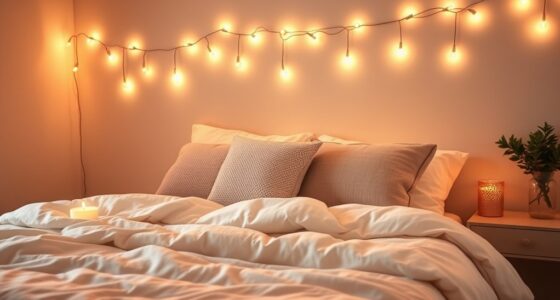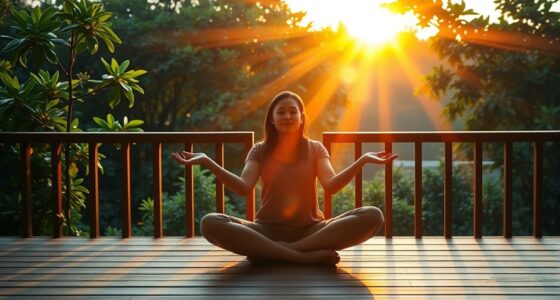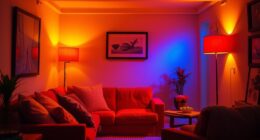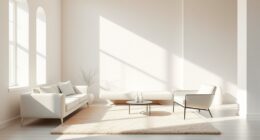Your personality greatly influences your ideal home, whether you’re an introvert or extrovert. If you’re more introverted, you’ll value quiet retreats, cozy corners, and private outdoor spaces to recharge. Extroverts might prefer open, lively areas for socializing and entertaining. Balancing these needs involves designing distinct zones for privacy and social interaction, choosing colors and decor that match your vibe, and creating natural light and outdoor links. Keep exploring how to craft a space that truly fits your personality.
Key Takeaways
- Introverts prefer private retreats, quiet corners, and soundproofed spaces for reflection and recharge.
- Extroverts enjoy open layouts, social zones, and outdoor areas that facilitate interaction and lively environments.
- Personal space needs influence furniture placement and zoning to promote comfort and functionality.
- Incorporating natural light and outdoor connections supports mood and aligns with individual social preferences.
- Flexible room dividers and multi-purpose areas allow customization for both solitude and socialization.
Recognizing Your Personal Space Preferences

Understanding your personal space preferences is essential for determining whether you’re more comfortable as an introvert or extrovert. Notice how much space you need to feel relaxed and at ease. If you crave quiet retreats where you can unwind alone, you likely value personal space highly. These spaces allow you to recharge and reflect without external disturbances. On the other hand, if you prefer being in lively environments with lots of interaction, your personal space needs might be less demanding. Recognizing how much solitude or social proximity you prefer helps clarify your personality type. Pay attention to your reactions in different settings. Your comfort level with personal space reveals whether you lean toward introversion or extroversion, guiding you in creating a home environment that suits your natural tendencies. Additionally, understanding how your space preferences impact your overall well-being can help you design a living space that promotes comfort and balance.
Designing for Privacy and Quiet Retreats
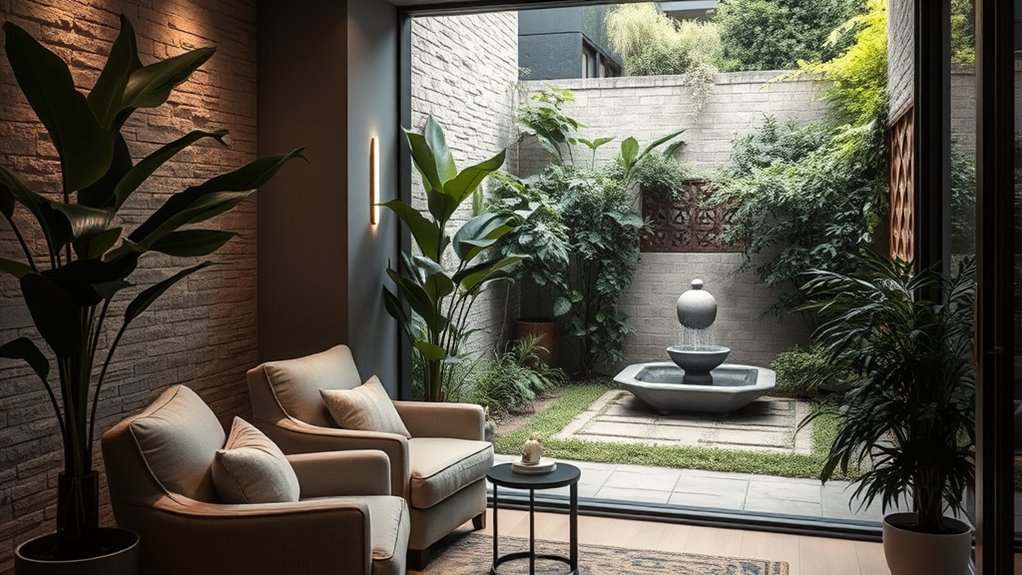
You can create peaceful spaces by incorporating soundproofing strategies that block noise and foster calm. Adding private outdoor areas gives you a retreat to unwind away from distractions. Flexible room dividers let you adjust your environment for maximum privacy whenever you need it. Incorporating cozy textiles like blankets and throws can also help muffle sound and create a sense of intimacy in the space.
Soundproofing Strategies
Creating a peaceful retreat within your home requires effective soundproofing strategies that block noise and guarantee privacy. You can achieve this by selecting the right soundproofing materials and enhancing acoustic insulation. Use dense, mass-loaded materials like drywall or cork to absorb sound waves. Consider installing acoustic panels or foam to dampen echoes and reduce background noise. Double-glazing windows or adding weatherstripping around doors can prevent sound leaks. Strategic placement of bookshelves or heavy curtains also helps absorb sound. These steps create a calm environment perfect for quiet reflection or focused work, whether you’re an introvert seeking solitude or simply value a peaceful space in a bustling home.
- Thick, dense walls with added acoustic insulation
- Soundproof curtains or heavy drapes
- Acoustic panels on walls and ceilings
- Double-glazed windows with sealing strips
- Door sweeps and weatherstripping
Private Outdoor Spaces
Designing a private outdoor space begins with strategic placement and thoughtful landscaping to block sightlines and reduce noise. Use landscape design elements like tall shrubs, fences, or walls to create natural privacy screens. Incorporate layered plantings for visual seclusion and sound buffering. Outdoor lighting plays a vital role, enabling you to enjoy your retreat at night while maintaining intimacy. Soft, warm lights tucked into landscape features or along pathways enhance the sense of enclosure without disrupting the tranquility. Focus on creating a quiet oasis where you can unwind without disturbances. By carefully blending landscape design and outdoor lighting, you craft a secluded haven tailored to your need for privacy and serenity—perfect for recharging and enjoying quiet moments alone. Additionally, selecting appropriate landscape design elements can maximize sound buffering and visual privacy, further enhancing your retreat.
Flexible Room Dividers
Flexible room dividers offer an adaptable solution for defining spaces and maintaining privacy within your outdoor retreats. They allow you to create quiet corners or open areas tailored to your mood or needs. Using multi purpose furniture, like foldable screens or sliding panels, you can easily reconfigure your space for social gatherings or solo relaxation. These adaptable layouts let you shift between openness and seclusion effortlessly. Imagine a lush garden with movable bamboo screens, retractable fabric partitions, or lightweight wooden slats. You could set up a cozy nook with a fold-away bench or a private meditation corner that opens up when needed. These versatile dividers help you customize your environment, making your outdoor space truly reflect your personality and privacy preferences.
Creating Social and Entertaining Areas
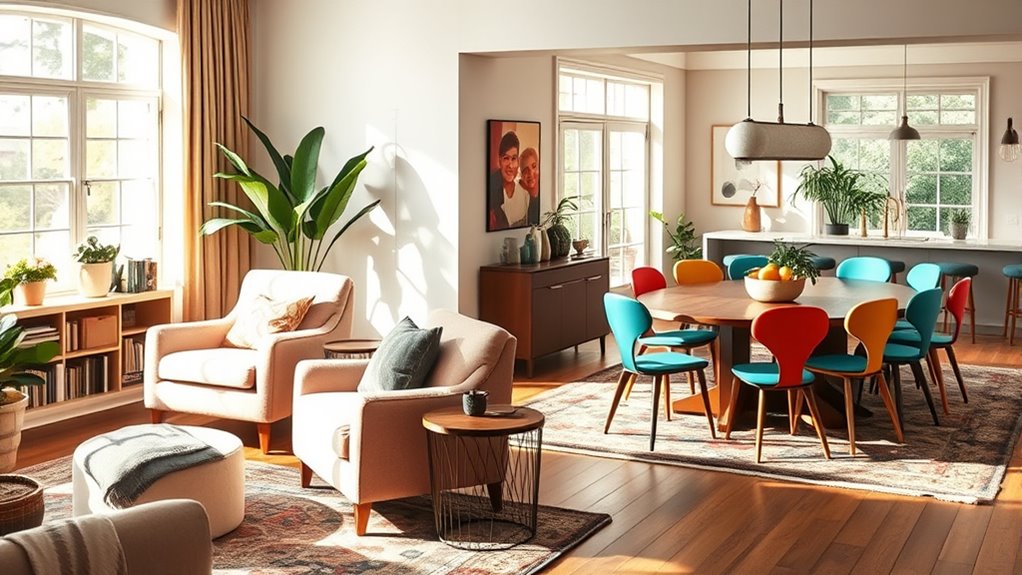
To foster social interaction and entertainment, you need to thoughtfully plan your communal spaces. Start by designing an outdoor entertaining area that encourages gathering, such as a patio with comfortable seating and a BBQ. Consider flexible layouts that can accommodate both small get-togethers and larger parties. Incorporate features like fire pits or outdoor heaters to extend usability into cooler months. For indoor spaces, create an open-concept living area that promotes community engagement, making it easy for guests to mingle. Use multi-functional furniture to maximize space and flexibility. Additionally, incorporating dog-friendly policies into your home design can enhance inclusivity for pet owners and create a welcoming environment for all guests. By thoughtfully designing these areas, you can cultivate a lively atmosphere for socializing, whether you’re hosting friends or engaging with neighbors. Your home becomes a hub for connection and shared experiences.
Choosing Colors and Decor That Match Your Style
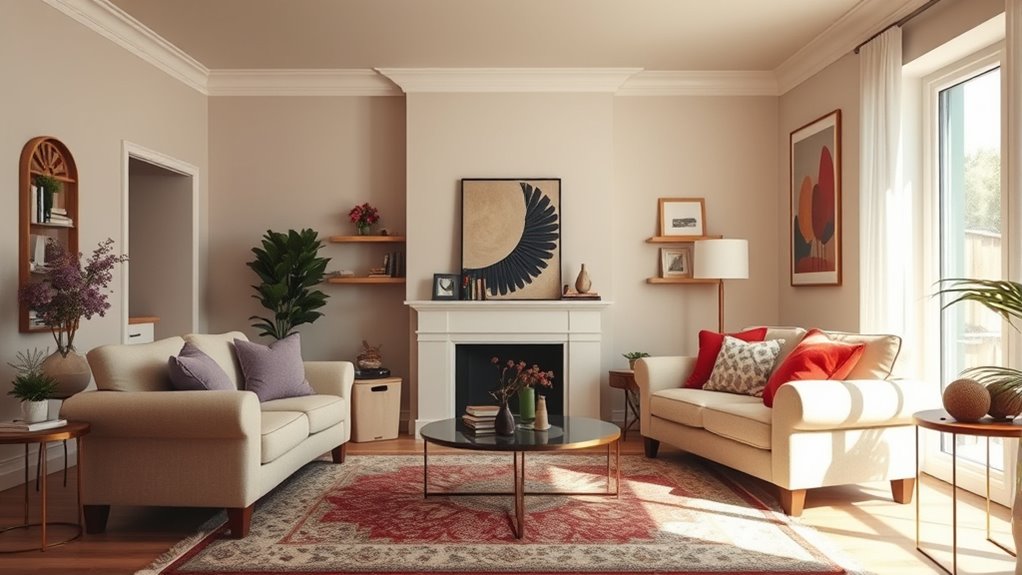
After creating inviting social spaces, the next step is selecting colors and decor that reflect your personal style. Your chosen color palettes set the mood and reveal your personality, whether you prefer calming neutrals or bold, energetic hues. Incorporate decorative accents like textured throw pillows, artwork, or unique vases to add personality and depth. Consider how different shades make you feel—soothing blues for tranquility or vibrant reds for excitement. Use these elements to craft a space that feels authentic and comfortable. Visualize cozy corners with warm tones or minimalist setups with cool, muted colors. Your decor choices should speak to your personality and lifestyle, creating a home that’s truly yours. Additionally, thinking about electric bike horsepower can inspire you to select energetic and dynamic decor themes that reflect vitality and movement.
Arranging Furniture for Comfort and Functionality
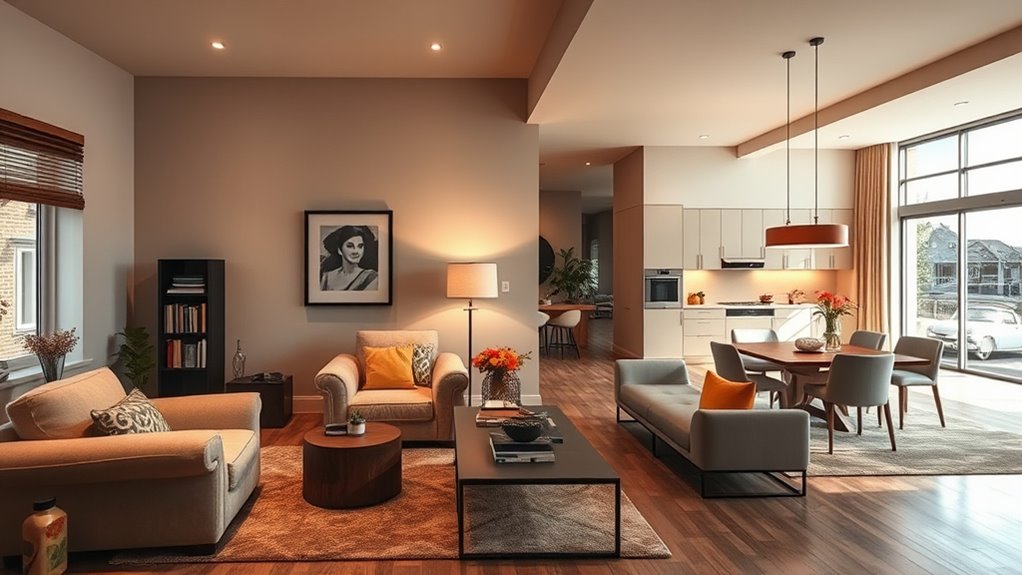
Arranging your furniture thoughtfully can dramatically enhance both comfort and practicality in your space. Focus on furniture arrangement that promotes easy movement and accessibility, ensuring every piece serves a purpose. Prioritize ergonomic placement by positioning seating and work areas at appropriate heights and distances to reduce strain. For social spaces, arrange furniture to foster conversation, creating a welcoming vibe. If you prefer solitude, set up cozy nooks with clear pathways to minimize clutter. Use scale and proportion wisely, avoiding overcrowding that hampers functionality. Keep frequently used items within reach, and consider flow—how you move through the room—when placing furniture. Additionally, space planning can help optimize your layout for better functionality and aesthetics. This strategic approach makes your home more comfortable, functional, and tailored to your lifestyle.
Incorporating Natural Light and Outdoor Connections
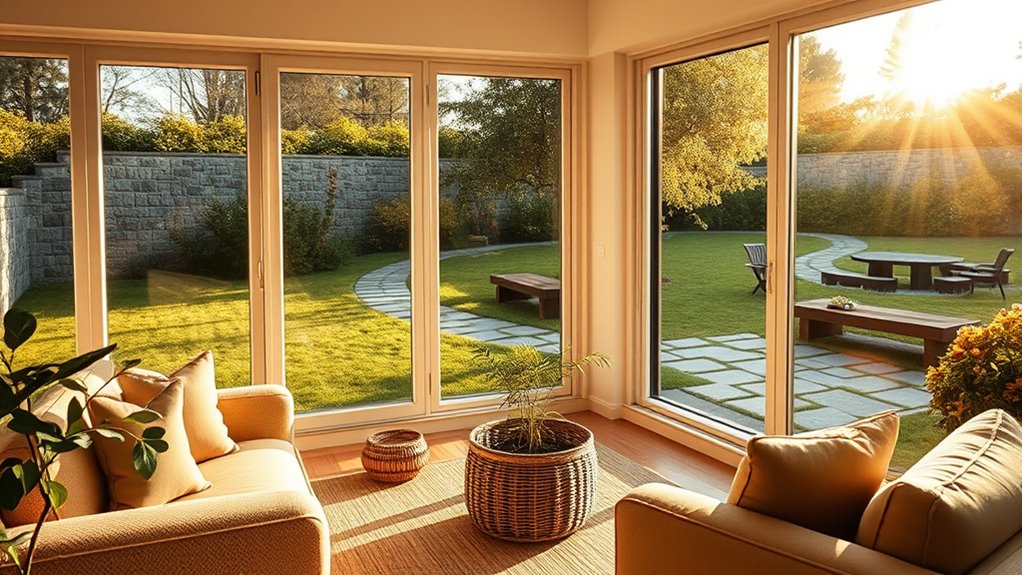
Natural light can lift your mood and make your space feel more inviting, whether you’re an introvert or extrovert. Creating a seamless flow between indoor and outdoor areas enhances brightness and encourages outdoor connections. Think about how you can maximize sunlight and design passages that invite you outside effortlessly. Incorporating natural light into your design can also reduce reliance on artificial lighting and create a more comfortable environment.
Brightness and Mood
Bright environments can markedly influence your mood, especially when you incorporate natural light and outdoor activities into your routine. Good lighting ambiance boosts your energy and promotes positive feelings, making your space more inviting. To create this effect, consider:
- Large windows that flood rooms with sunlight
- Skylights that bring in overhead daylight
- Outdoor patios or terraces for fresh air and views
- Reflective surfaces to amplify natural light
- Verdant plants that connect you with nature
These elements enhance mood through light and outdoor connections, encouraging a sense of calm or vitality based on your personality. Natural brightness not only lifts your spirits but also fosters mood enhancement, making your home a true sanctuary tailored to your emotional needs.
Seamless Indoor-Outdoor Flow
Creating a seamless indoor-outdoor flow enhances your living space by blurring the boundaries between inside and outside. You can achieve this through thoughtful garden integration and outdoor lighting that invites nature into your home. Large glass doors or windows connect your rooms to outdoor spaces, making them feel like extensions of your home. Proper outdoor lighting highlights these crossings, creating a cozy ambiance after sunset. Consider how your personality influences this design—extroverts may prefer lively, open spaces, while introverts might favor more intimate, secluded retreats. Using outdoor connections effectively can also involve incorporating self watering plant pots to maintain healthy, thriving greenery both indoors and outdoors.
Balancing Open Spaces and Cozy Nooks

Finding the right balance between open spaces and cozy nooks is essential for a comfortable and functional environment. Open concept layouts promote social interaction, while cozy nooks offer retreats for solitude. To achieve this balance, consider integrating multi purpose rooms that serve both functions. Visualize a spacious living area with an inviting reading corner tucked into a quiet corner. Imagine a versatile space that functions as a playroom during the day and a quiet workspace at night. Think of a dining area that flows seamlessly into an open kitchen, with a small nook nearby for intimate conversations. Envision a large, airy room broken up by furniture to create designated zones. Incorporating well-designed educational toys can also help foster development and engagement in shared or quiet spaces. These elements help tailor your space to your personality, blending openness with privacy.
Tips for Maintaining Your Ideal Environment
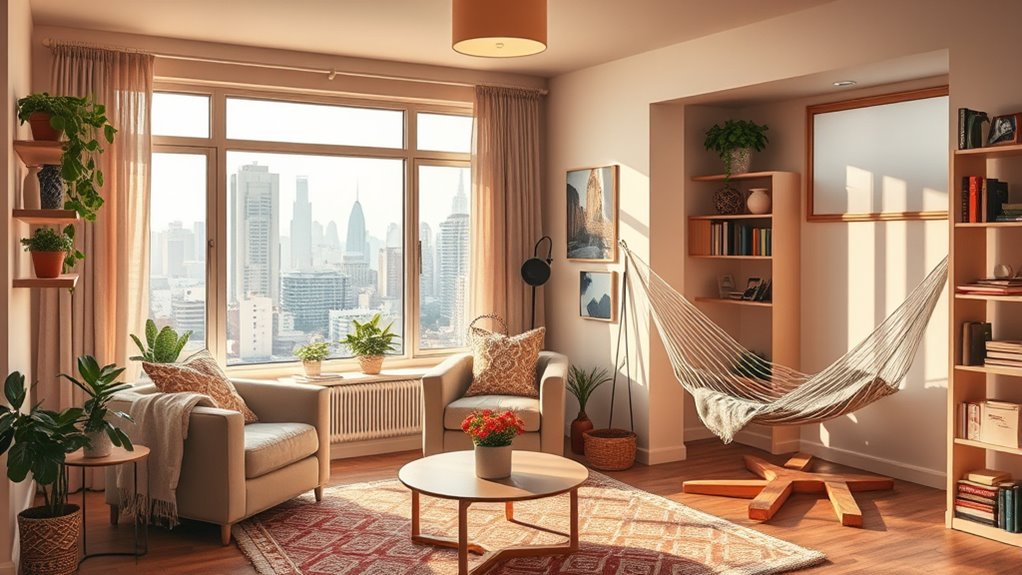
To maintain your ideal environment, start by establishing clear boundaries between different zones. This helps you switch smoothly between activity types and mood settings. Use personalized lighting to create distinct atmospheres—softer, warm lights for relaxation, brighter lights for work or socializing. Adjust your lighting to match your needs, making your space more functional and inviting. Additionally, thoughtful furniture arrangement plays a key role; position pieces to foster privacy or encourage social interaction, depending on your personality. For introverts, create cozy corners that offer retreat, while extroverts benefit from open, communal setups. Regularly reassess your space to ensure it continues to serve your evolving needs, keeping it balanced, comfortable, and aligned with your lifestyle. Incorporating elements like personalized lighting can also help you optimize your environment for your personality type.
Frequently Asked Questions
How Does Personality Influence Home Layout Preferences?
Your personality influences your home layout preferences by shaping how much personal space you need and your lighting preferences. You might prefer cozy, quiet corners for relaxation or open spaces for socializing. Bright lighting could energize you, while softer light might create a calming atmosphere. Your choices reflect your desire for comfort and functionality, ensuring your home suits your daily routines and personal style.
Can Home Design Promote Social Interaction or Solitude Effectively?
You can design your home to promote either social interaction or solitude effectively. Incorporate spacious communal areas like open kitchens or living rooms to encourage gatherings, while creating designated personal spaces such as quiet nooks or private bedrooms for solitude. By balancing these elements, you guarantee your home adapts to your needs, offering the right mix of personal space and communal areas to foster connection or tranquility as desired.
What Are the Best Features for Energy-Efficient Homes for Introverts?
Your home should be a sanctuary that whispers comfort. For introverts, the best energy-efficient features include energy-saving appliances that reduce noise and utility bills, and natural lighting that creates a peaceful atmosphere. Large windows or skylights invite sunlight in, making spaces feel open yet private. These elements help you recharge without sacrificing sustainability, turning your home into a cozy retreat that’s both eco-friendly and perfectly suited to your need for solitude.
How Do Cultural Differences Affect Home Personalization Choices?
Cultural differences greatly influence your home personalization choices, as cultural aesthetics shape your decor and design preferences. Personalization customs guide how you arrange spaces, select colors, and incorporate meaningful symbols. You adapt your home to reflect your cultural background, creating a space that feels authentic and comfortable. Embracing these cultural influences allows you to design a home that truly represents your identity and respects your traditions.
Are There Universal Design Tips Suitable for Both Introverts and Extroverts?
You can create a home that suits everyone by focusing on universal design tips. Incorporate multifunctional spaces that serve different needs, like a home office that doubles as a guest room. Use natural lighting to make the space welcoming and adaptable. These features benefit both introverts and extroverts, fostering comfort and flexibility. Prioritizing versatile, well-lit areas guarantees your home feels inviting for all personalities.
Conclusion
No matter if you’re an introvert or extrovert, designing your space to match your personality creates true comfort. Some might think it’s limiting, but tailoring your home enhances your well-being and makes daily living more fulfilling. Embrace your preferences—whether cozy retreats or lively gathering spots—and remember, your home should reflect who you are. When you prioritize what feels right, you’ll find your space naturally supports your lifestyle and brings you peace.



